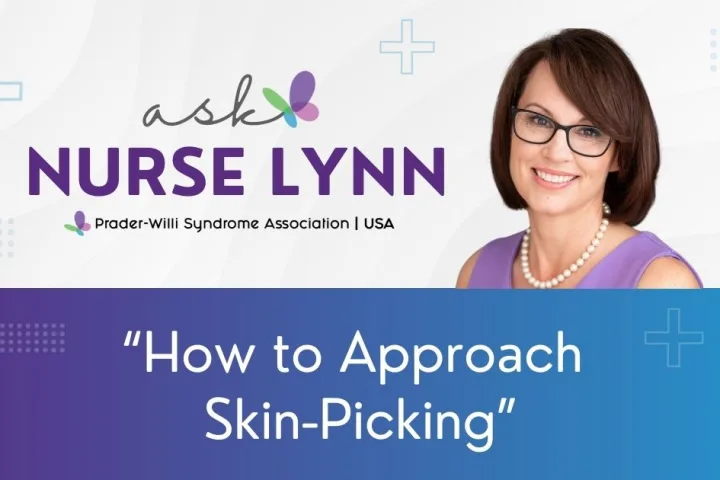Question:
Male, 20 years old, UPD
Our son, 20 years old, UPD, since his childhood presented one of the characteristics of the Syndrome: SKIN PICK. We have treated him with multiple creams and therapeutic aids. But now, he started with the ANAL skin pick, and it is being very difficult for us to handle these situations and, above all, to try to avoid them. Do you have any suggestions or advice? Thank you very much.
Nurse Lynn’s Response:
Rectal picking can be a challenging and distressing behavior sometimes observed in individuals with PWS. It is often underreported, as it can be a sensitive topic to discuss. This behavior may be driven by sensory-seeking tendencies, anxiety, or discomfort related to constipation or other gastrointestinal issues. Addressing the underlying causes is the first step, followed by structured sensory and behavioral strategies to help manage and reduce the behavior.
1. Address Underlying Medical Causes (first priority)
- *Constipation: Ensure bowel movements are regular, and stools are soft.
- *Skin irritation or discomfort: Check for hemorrhoids, anal fissures, or irritation. Topical treatments like barrier creams (e.g., zinc oxide) can soothe irritation and prevent further damage.
- *Infections: Address any signs of infection, such as redness, swelling, or unusual odor, with a healthcare provider’s guidance.
2. Behavioral Interventions
- *Distraction and Engagement: Keep hands busy with sensory toys (e.g., stress balls, fidget toys) or engaging activities.
- *Structured Routine: A predictable daily schedule can reduce anxiety and boredom, which may trigger picking.
- *Emotional regulation techniques: mindfulness, calming bedtime routine, cognitive-behavioral strategies, deep breathing exercises, or guided meditation are some examples
3. Clothing Modifications
- *Restrictive Clothing: Using one-piece outfits (e.g., bodysuits or jumpsuits) or clothing with hard-to-access zippers or snaps, may be determined to be clinically necessary in extreme situations.
4. Monitor and Modify Environment
- *Ensure a calm, low-stress environment as stress can exacerbate behaviors.
- *Identify and minimize triggers for anxiety or sensory-seeking behavior.
5. Include Sensory Options
- *Incorporating sensory strategies is a crucial part of addressing rectal picking in individuals with PWS, as this behavior may be related to sensory-seeking tendencies. Here are some specific sensory strategies:
Tactile Sensory Toys
- *Fidget toys: Stress balls, pop-it toys, or textured sensory balls.
- *Theraputty: Soft, resistive putty that can be stretched, squeezed, or shaped.
- *Weighted objects: Weighted lap pads, blankets, or vests to provide calming pressure.
- *Sensory bins: Containers filled with rice, sand, or beans for tactile exploration.
Deep Pressure Activities
Offer calming sensory input through:
- *Weighted blankets or compression clothing.
- *Hugs or firm back massages (if the individual is comfortable).
- *Body socks (stretchy, enclosed fabric for proprioceptive feedback).
Hand Occupation
Provide tasks that involve the hands and keep them busy:
- *Kneading dough, shaping clay, or playing with slime.
- *Beading or threading activities.
- *Squeezing sponges or using spray bottles during water play or cleaning.
Environmental Modifications
Create a sensory-friendly environment to reduce the desire for picking:
- *Calming sensory spaces: Include dim lighting, soft music, and cozy seating to promote relaxation.
- *Visual distractions: Provide access to visually engaging items like lava lamps or light-up toys.
- *Auditory input: Noise-canceling headphones or calming soundtracks to reduce sensory overload.
Body Awareness and Sensory Regulation
Help the individual become more attuned to their body and sensory needs:
- *Movement activities: Yoga, stretching, or jumping on a trampoline to provide proprioceptive feedback.
- *Vibration tools: Hand-held massagers or vibrating toys can satisfy sensory-seeking behaviors.
Therapeutic Sensory Programs
- *Occupational therapy: Work with an OT to develop a sensory diet tailored to the individual’s specific needs.
- *Weighted and compression clothing: Helps provide constant sensory input, which can reduce the drive for self-directed behaviors like rectal picking.
Resources:
I have linked a few helpful articles along with a sample sensory plan for the day
rectal_picking_algorithm_2017.pdf
Do you have a question for Nurse Lynn? Submit your question here:
Share this!





 Perry A. Zirkel has written more than 1,500 publications on various aspects of school law, with an emphasis on legal issues in special education. He writes a regular column for NAESP’s Principal magazine and NASP’s Communiqué newsletter, and he did so previously for Phi Delta Kappan and Teaching Exceptional Children.
Perry A. Zirkel has written more than 1,500 publications on various aspects of school law, with an emphasis on legal issues in special education. He writes a regular column for NAESP’s Principal magazine and NASP’s Communiqué newsletter, and he did so previously for Phi Delta Kappan and Teaching Exceptional Children. Jennifer Bolander has been serving as a Special Education Specialist for PWSA (USA) since October of 2015. She is a graduate of John Carroll University and lives in Ohio with her husband Brad and daughters Kate (17), and Sophia (13) who was born with PWS.
Jennifer Bolander has been serving as a Special Education Specialist for PWSA (USA) since October of 2015. She is a graduate of John Carroll University and lives in Ohio with her husband Brad and daughters Kate (17), and Sophia (13) who was born with PWS. Dr. Amy McTighe is the PWS Program Manager and Inpatient Teacher at the Center for Prader-Willi Syndrome at the Children’s Institute of Pittsburgh. She graduated from Duquesne University receiving her Bachelor’s and Master’s degree in Education with a focus on elementary education, special education, and language arts.
Dr. Amy McTighe is the PWS Program Manager and Inpatient Teacher at the Center for Prader-Willi Syndrome at the Children’s Institute of Pittsburgh. She graduated from Duquesne University receiving her Bachelor’s and Master’s degree in Education with a focus on elementary education, special education, and language arts. Evan has worked with the Prader-Willi Syndrome Association (USA) since 2007 primarily as a Crisis Intervention and Family Support Counselor. Evans works with parents and schools to foster strong collaborative relationships and appropriate educational environments for students with PWS.
Evan has worked with the Prader-Willi Syndrome Association (USA) since 2007 primarily as a Crisis Intervention and Family Support Counselor. Evans works with parents and schools to foster strong collaborative relationships and appropriate educational environments for students with PWS. Staci Zimmerman works for Prader-Willi Syndrome Association of Colorado as an Individualized Education Program (IEP) consultant. Staci collaborates with the PWS multi-disciplinary clinic at the Children’s Hospital in Denver supporting families and school districts around the United States with their child’s Individual Educational Plan.
Staci Zimmerman works for Prader-Willi Syndrome Association of Colorado as an Individualized Education Program (IEP) consultant. Staci collaborates with the PWS multi-disciplinary clinic at the Children’s Hospital in Denver supporting families and school districts around the United States with their child’s Individual Educational Plan. Founded in 2001, SDLC is a non-profit legal services organization dedicated to protecting and advancing the legal rights of people with disabilities throughout the South. It partners with the Southern Poverty Law Center, Protection and Advocacy (P&A) programs, Legal Services Corporations (LSC) and disability organizations on major, systemic disability rights issues involving the Individuals with Disabilities Education Act (IDEA), Americans with Disabilities Act (ADA), and the federal Medicaid Act. Recently in November 2014, Jim retired.
Founded in 2001, SDLC is a non-profit legal services organization dedicated to protecting and advancing the legal rights of people with disabilities throughout the South. It partners with the Southern Poverty Law Center, Protection and Advocacy (P&A) programs, Legal Services Corporations (LSC) and disability organizations on major, systemic disability rights issues involving the Individuals with Disabilities Education Act (IDEA), Americans with Disabilities Act (ADA), and the federal Medicaid Act. Recently in November 2014, Jim retired.